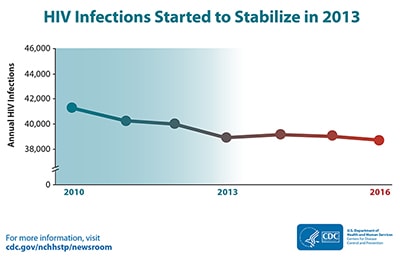HIV Incidence: Estimated Annual Infections in the U.S., 2010-2016
February 27, 2019 — Progress in HIV prevention has stalled; need for immediate action — ‘Ending the Epidemic: A Plan for America’
The dramatic decline in annual HIV infections has stopped and new infections has stabilized in recent years, according to a CDC report published today. The report provides the most recent data on HIV trends in America from 2010 to 2016. It shows that after about five years of substantial declines, the number of HIV infections began to level off in 2013 at about 39,000 infections per year. In addition to the overall trend, the new report examines HIV infections among multiple subgroups. Data indicate that annual HIV infections declined in some populations, but increased in others. CDC estimates that the decline in HIV infections has plateaued because effective HIV prevention and treatment are not adequately reaching those who could most benefit from them.
- Press Release: Progress in HIV prevention has stalled; need for immediate action — ‘Ending the Epidemic: A Plan for America’
- Fact Sheet: HIV Incidence: Estimated Annual Infections in the U.S., 2010-2016Cdc-pdf
- Data Summary: Estimated Annual HIV Infections in the U.S., 2010-2016Cdc-pdf
- Full Report: Estimated HIV Incidence and Prevalence in the United States 2010–2016 Cdc-pdf
- HIV.govExternal
Graphics:
HIV Incidence: Estimated Annual Infections in the U.S., 2010-2016
These high-resolution, public domain images are ready to download and print in your publication. Click on a graphic to see it in high-resolution. For your convenience, we have included a table that contains the specific data from the report used to generate these charts. These images are in the public domain and are thus free of any copyright restrictions. As a matter of courtesy, we ask that the content provider be credited and notified of any public or private usage of an image.
View High Resolution Version
HIV incidence in the United States have been reduced by more than two-thirds since the height of the epidemic in the mid-1980s, but CDC data indicate that progress has stalled in recent years.


